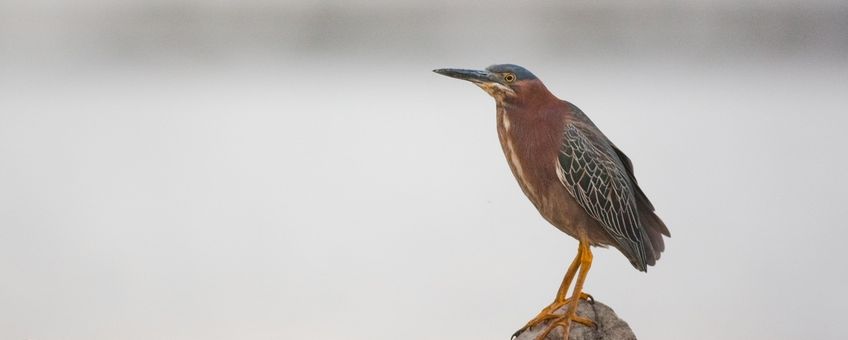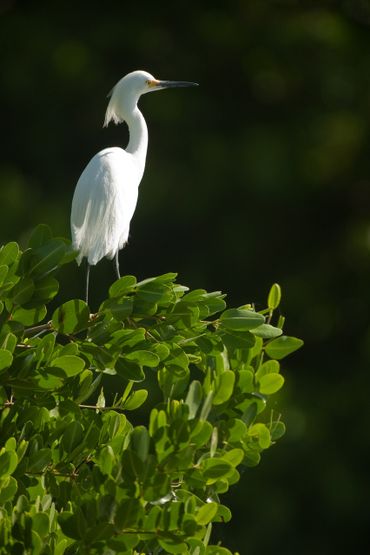
Study reveals large number of new bird species for the island of Saba
Dutch Caribbean Nature Alliance (DCNA)Whether perched on the coast’s steep cliffs or foraging in Mt. Scenery’s lush rainforest, birds can be seen all over Saba. The variety of birds is high for such a small island and can be attributed to the diversity and richness of Saba's habitats. The actual number of bird species that reside or visit the island has remained a point of debate and has fluctuated over time depending on which publication is cited. The last thorough study of Saba’s avifauna was carried out in 1983 and described 58 species, with 6 additional species observed in the surrounding seas. Since then, the number of bird species cited in publications has ranged from 56 to 87. In order to clarify the composition of Saba’s avifauna, the birds of the island were studied for two years between 2010 and 2012, with the addition of observations made by reliable Saba birdwatchers. The resulting updated checklist for the birds of Saba shows that the island has an even richer avifauna than previously believed, with a total of 107 species including 31 new species records.
 The majority of new bird species recorded for Saba are residents or visitors to the nearby island of Saint Martin. Saba is situated just 45 kilometres south-west of this island, a short distance for birds to travel. A number of birds that are common or breed on Saint Martin have now been established as either occasional visitors to Saba and its surrounding seas (American Oystercatcher, Snowy Egret, Least Tern) or vagrants (Blue-winged Teal, Black-necked Stilt, Ruddy Turnstone). A number of passage migrants and visitors to Saint Martin are now confirmed as also stopping on Saba, either regularly (White-winged Dove), occasionally (Semipalmated Plover, Louisiana Waterthrush, Ring-billed Gull) or rarely (Wilson’s Snipe and Sandwich Tern). Other species have been mentioned as vagrants to the Lesser Antilles and are now confirmed as vagrants to Saba (Rose-breasted Grosbeak, Yellow-throated Vireo, Cliff Swallow, Black-throated Green Warbler). Additionally, five new species of bird have been introduced to the island, three of which have begun to breed (House Sparrow, Eurasian Collared Dove, Brown-throated Parakeet), while the other two species remain feral (Rock Pigeon and Red Junglefowl).
The majority of new bird species recorded for Saba are residents or visitors to the nearby island of Saint Martin. Saba is situated just 45 kilometres south-west of this island, a short distance for birds to travel. A number of birds that are common or breed on Saint Martin have now been established as either occasional visitors to Saba and its surrounding seas (American Oystercatcher, Snowy Egret, Least Tern) or vagrants (Blue-winged Teal, Black-necked Stilt, Ruddy Turnstone). A number of passage migrants and visitors to Saint Martin are now confirmed as also stopping on Saba, either regularly (White-winged Dove), occasionally (Semipalmated Plover, Louisiana Waterthrush, Ring-billed Gull) or rarely (Wilson’s Snipe and Sandwich Tern). Other species have been mentioned as vagrants to the Lesser Antilles and are now confirmed as vagrants to Saba (Rose-breasted Grosbeak, Yellow-throated Vireo, Cliff Swallow, Black-throated Green Warbler). Additionally, five new species of bird have been introduced to the island, three of which have begun to breed (House Sparrow, Eurasian Collared Dove, Brown-throated Parakeet), while the other two species remain feral (Rock Pigeon and Red Junglefowl).
Saba’s rocky shores and islands are especially significant for seabirds in the region, with breeding places of seabirds under strain all over the Caribbean. The island’s coastline has been declared an Important Bird Area (IBA) by Birdlife International as the area supports globally important populations of breeding seabirds, notably Red-billed Tropicbirds and Audubon’s Shearwaters. Saba is an important location for the Red-billed Tropicbird, with a recent estimate of 1,200 to 1,500 pairs. The breeding status of the Sooty Tern has been confirmed, however the breeding status of others could not be confirmed (Cattle Egret, Green Heron, Yellow-crowned Night-Heron, Black-whiskered Vireo). Two species were also confirmed as locally extirpated: the White-tailed Tropicbird, which was once recorded as breeding on Saba, and the Antillean Euphonia, which has not been seen on the island for over 50 years.
Despite being nicknamed 'the Unspoiled Queen', a newly published report by Wageningen University (2018) on the state of Saba’s nature has revealed that most of the island’s habitats are under strain and are now degraded to varying extents. This is of great concern for Saba’s avifauna which depends on the health of these habitats for their well-being. Saba's cloud forest at the top of Mt Scenery is a critical habitat for the regionally rare and endemic sub-species of Brown Trembler (Cinclocerthiaruficauda tremula) that occurs and breeds on Saba but the vegetation has suffered much damage from hurricanes in the past decade. Invasive species also pose a significant threat, notably rats and feral cats. Feral cats in the lower parts of the island are an especially serious threat for nesting seabirds. In the higher area parts of the island, rats are very numerous in the rainforest where they steal and consume bird eggs. The status of key and endangered bird species on Saba will have to be closely monitored to understand how growing local, regional and global threats to the island’s habitats are impacting the avifauna. This includes three endangered species that have just been added to Saba’s bird checklist: the White-crowned Pigeon (Near Threatened), whose population on Saint Martin has dramatically declined due to hunting; the Chimney Swift (Vulnerable) and the Blackpoll Warbler (Near Threatened).
Text: Florence Depondt and Tineke van Bussel, DCNA
Photos: Rostislav Stach (lead photo: Green Heron)
